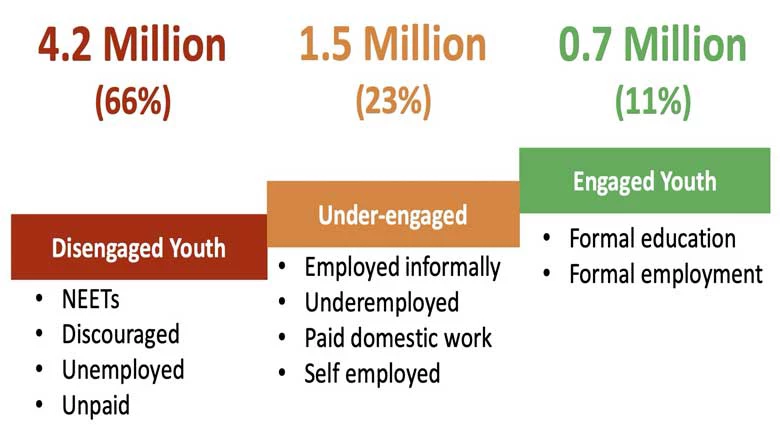 A youth working in pot making factory in Kabwe. Photo: Carlyn Hambuba / World Bank
A youth working in pot making factory in Kabwe. Photo: Carlyn Hambuba / World Bank
Darius Chiiko is a young Zambian entrepreneur in his early 30s. He lives in Lusaka and occasionally offers guided tours around the city. Darius’s tourism guide business boomed thanks to one of his clients, a Dutch YouTuber, who posted a video of his time with Darius. Nonetheless, Darius’s business success could rapidly fade, as he lacks the digital skills necessary to continue marketing his services on social media. He would like to take some training in digital skills and become a certified tour guide but finds it difficult to access flexible learning programs to build his skills and financing to build his business. Millions of youths in Zambia are in Darius’s dilemma, facing barriers to skill acquisition and productivity, and struggling with personal growth.
In close collaboration with Zambia’s Ministry of Technology and Science (MoTS) and the Technical Education, Vocational and Entrepreneurship Training Authority (TEVETA), the World Bank recently launched the “Promoting Skills Development for Youth in Zambia” report. The report provides an overview of Zambia’s skills development landscape and the challenges youth face concerning access to skills and employment.
The report finds that close to 90% of all youth in Zambia are not harnessing their economic potential. Of the close to 6.4 million youth (15-35 years old) in Zambia in 2021, about 3 million were not in education, employment, or training (the so-called NEETs) or gave up trying to find a job; 1.2 million were unemployed or unpaid workers; and 1.5 million were engaged in low-pay, low-productivity informal employment (Figure 1). At the same time, the research finds that only 38 thousand youth (about 0.05%) had access to some form of skills training.
 Figure 1: Zambian Youth [15-35] according to their education and employment status
Figure 1: Zambian Youth [15-35] according to their education and employment status
Zambia’s system for skills development is underfunded and ripe for investment
The report finds that between 2015 and 2021, the vocational skills training system received only 2.2% of the government’s expenditures on education, very low by international standards. Globally, low- and middle-income countries spend on average 5% of their education budget on vocational training and skills. Countries like China, India, and Brazil spend between 10 to 15%.
Yet, Zambia has an adequate ecosystem for skills development. The country’s Technical Education, Vocational and Entrepreneurship Training (TEVET) institutions are autonomous, they operate under clear quality standards and guidelines, and most academic programs have occupational standards and certification mechanisms. TEVETA is also championing a curricula reform to expand its academic offer (including 3 months and 6 months skilling programs), offer more entrepreneurship training, expand hybrid training modalities, and promote work-based training, including apprenticeships and internships, in close coordination with employers.
Despite these supportive policy directives, the local capacity of training institutes is excessively low at all levels. Zambia has about 300 post-secondary TEVETA registered training institutions. Only a small minority (8%) attain acceptable quality standards, equivalent to Level 1 according to the National System of Quality Assurance. Most institutions lack basic internet connectivity and adequate infrastructure (including workshops and equipment) for technical training. Moreover, the overall management capacity of school principals is limited, and teachers are often not equipped with the required digital and pedagogical skills necessary to promote a more digital and hybrid shift in the academic offer.
How can Zambia build a better vocational skills system?
While it will be imperative for the Zambian government to channel more investments to the vocational skills sector, it is important to realize that Zambia is pressed by tight fiscal constraints. In such a context, below are some of the options we discuss in the Promoting Skills Development for Youth in Zambia Report:
- Tap into the available capacity of the secondary education system. Zambia is amid an ambitious expansion of its secondary education system. Its secondary education is highly academic and does not offer enough technical training tracks. Only 1.12% of students enrolled in secondary education attain a technical certification (known are SSVET certificate). A quick gain would be to expand vocational educational tracks in secondary education.
- Promote innovative financial models to attract private sector financing. The Zambian government could introduce innovative financial models to attract capital from private sector stakeholders, donors, and large philanthropic investors. Countries like Mexico are developing “financing mechanism matching” whereby the government matches dollar for dollar any contribution from private sector stakeholders or international donors to financial endowments such as vocational training funds. Countries like Morocco and Ethiopia have managed their training funds by promoting competitive allocation of resources based on results-based contracts with private and public training providers. These types of contracts can create incentives for providers to accelerate reforms pertaining to curricula reform, change in academic offerings, and quality assurance.
- Tap into the opportunities offered by the growth of digital. Hybrid learning, which combines traditional face-to-face instruction with online learning, could enhance access to training by allowing students to balance their studies with work or other commitments and making technical education accessible to those who may not be able to attend in-person classes due to geographical or financial constraints, especially women. Successful hybrid learning requires good connectivity, access to devices, digitalized teaching content, and trained teachers.
Our report underscores the need for significant investment and innovative approaches to create a more robust, inclusive, and sustainable vocational training system in Zambia, which can benefit youth, growth in the economy, and overall development efforts.





Join the Conversation